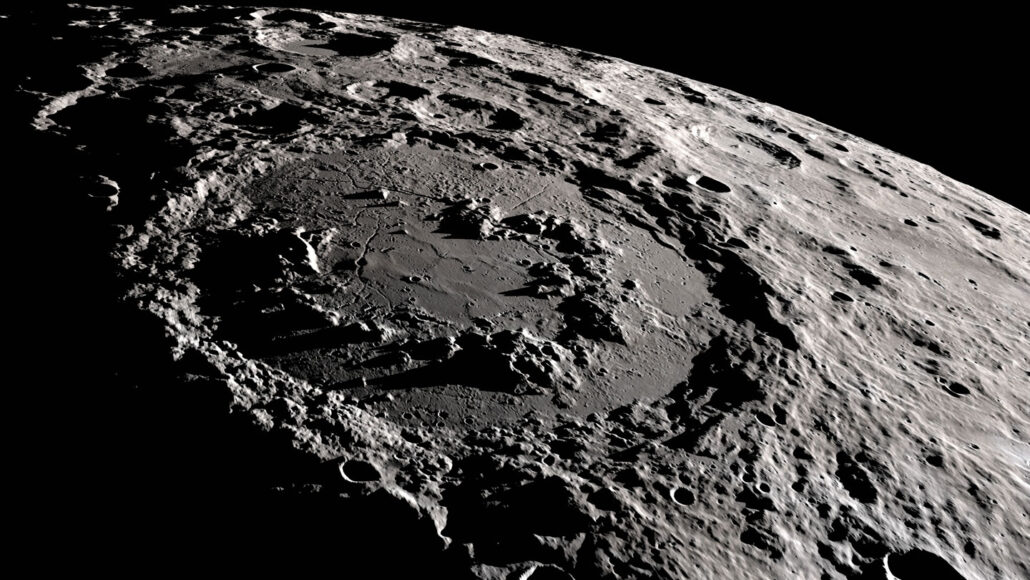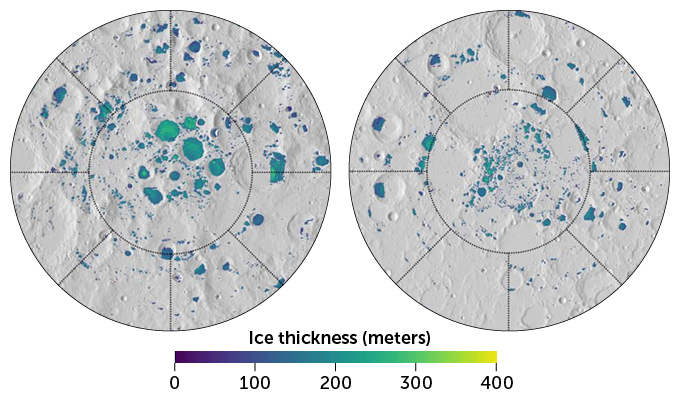Ancient volcanoes may have left ice at the moon’s poles
The eruptions may have produced several temporary atmospheres that held water vapor

Schrödinger crater (shown) lies near the moon’s south pole. Ice might have arrived at both lunar poles as water vapor released by ancient volcanic eruptions.
NASA GSFC Scientific Visualization Studio
By Anna Gibbs
Four billion years ago, lava spilled onto the moon’s crust. That molten material molded “the man in the moon” and other patterns seen on the lunar surface today. The moon’s ancient volcanoes may have also left another, much colder, legacy: ice.
For two billion years, volcanic eruptions may have spewed water vapor into space around the moon. Those sprays may have even created many short-lived lunar atmospheres. Water vapor could have wafted through these atmospheres before settling as ice at the poles. Researchers shared their new analysis in the May Planetary Science Journal.
Scientists confirmed in 2009 that ice exists on the moon. Since then, researchers have debated the origin of that water. It could have arrived on asteroids or comets. It also could have arisen from electrically charged atoms carried by the solar wind. Or maybe the water came from the moon itself — as vapor belched out by volcanic eruptions. Those eruptions would have occurred between 4 billion and 2 billion years ago.
The mysterious source and extent of moon ice is “a really interesting question,” says Andrew Wilcoski. He’s a planetary scientist at the University of Colorado Boulder. Scientists still don’t know just how much ice is on the moon. Also unclear: exactly where that ice is.
Modeling the moon
Wilcoski and his colleagues wanted to know if volcanoes might be a source of that lunar ice. Back in the heyday of lunar volcanism, eruptions happened about once every 22,000 years. The researchers assumed that water made up about a third of the gases belched out by those volcanoes. (This was based on samples of ancient lunar magma.) Using that information, the team calculated how much water such eruptions might have released overall.
The number was huge: 20 quadrillion kilograms (2,200 trillion tons)! That’s about the mass of the water in all five Great Lakes combined.

Some of this vapor would have been lost as sunlight broke down some water molecules. The solar wind would have blown other water molecules off the moon. But at the frigid poles, some water could have stuck to the surface as ice.
For that to happen, water vapor would have to condense into ice faster than it escaped the moon. Wilcoski’s team used a computer model to calculate and compare these rates. That model accounted for many important factors. These included the moon’s surface temperature, gas pressure and the loss of some vapor to frost. The frost — a type of thin ice — formed along the side of the moon like the icy glaze on a car windshield early in the morning.
If humans had existed billions of years ago, “you would potentially look up at the moon and see this sliver of white,” says Wilcoski. Most of the water in that frost wouldn’t have been able to travel to the poles (which is why it had to be accounted for in the model).
About 40 percent of the total water vapor in eruptions could have settled into ice at the poles, the team found. Over billions of years, some of this ice would have turned back to vapor and escaped into space. The computer model predicts that today, ice deposits on the moon are up to hundreds of meters (more than 700 feet) thick. It also predicts that the lunar south pole would be about twice as icy as the north pole.
Traveling from atmosphere to pole
The new results make sense with what scientists know about the moon. Researchers had long assumed that ice dominates at the poles because it gets stuck in places called “cold traps.” These are pockets in the lunar landscape that are always in shadow. They would remain so cold that ice there could stay frozen for billions of years.
“There are some places at the lunar poles that are as cold as Pluto,” says Margaret Landis. Like Wilcoski, this planetary scientist works at the University of Colorado Boulder.
To reach the poles, volcanic water vapor would probably have to drift through an atmosphere, the researchers say. An atmosphere would let water molecules travel around the moon and help keep them from fleeing into space. The new computer model suggests that each volcanic eruption spawned a new atmosphere. That atmosphere would have lingered for about 2,500 years before disappearing. Then, the moon would be atmosphere-free again until the next eruption some 20,000 years later.

Educators and Parents, Sign Up for The Cheat Sheet
Weekly updates to help you use Science News Explores in the learning environment
Thank you for signing up!
There was a problem signing you up.
This part of the story is most captivating to Parvathy Prem. She’s a planetary scientist who wasn’t involved in the research. She works at Johns Hopkins Applied Physics Laboratory in Laurel, Md. “It’s a really interesting act of imagination,” she says. “How do you create atmospheres from scratch? And why do they sometimes go away?” She says “the polar ices are one way to find out.”
If lunar ice started as water vapor from volcanoes, that ice may retain a memory of that origin. Sulfur in the ice, for example, would suggest it came from a volcano rather than, say, an asteroid. Future moon missions plan to drill for ice samples that could confirm the ice’s origin.
Looking for sulfur will be important when thinking about lunar resources. Water reserves on the moon could someday be mined by astronauts for water or rocket fuel. But if all the lunar water is laced with sulfur, Landis says, it may not be safe to drink. “That’s a pretty critical thing to know if you plan on bringing a straw with you to the moon.”







